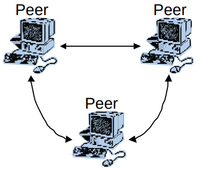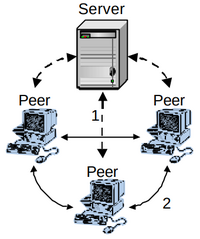Peer-to-Peer (P2P) Networking System
A Peer-to-Peer (P2P) Networking System is a Distributed Networking System that in which individual nodes in the network (called "peers") act as both suppliers and consumers of resources.
- AKA: Peer-to-Peer (P2P) Network, Peer-to-Peer (P2P) Computing System, Distributed Peer-to-Peer (P2P) Computing System.
- Context:
- It can range from being a Pure P2P System to being a Hybrid P2P System.
- It is usually a Decentralized Networking System as well.
- …
- Example(s):
- a Collaborative P2P System (e.g. Bandara & Jayasumana, 2013),
- a BitCoin System,
- a Friend-to-Friend Networking System,
- a P2P Social Networking System such as:
- a Pure P2P System such as:
- a Hybrid P2P System such as:
- …
- Counter-Example(s):
- See: Distributed Computing, Network Architecture, Node (Networking), Client–Server, Processing Power, Disk Storage, Network Bandwidth, Client (Computing), Server (Computing), Decentralized Networking System.
References
2021
- (Wikipedia, 2021) ⇒ https://en.wikipedia.org/wiki/Peer-to-peer Retrieved:2021-10-1.
- Peer-to-peer (P2P) computing or networking is a distributed application architecture that partitions tasks or workloads between peers. Peers are equally privileged, equipotent participants in the application. They are said to form a peer-to-peer network of nodes.
Peers make a portion of their resources, such as processing power, disk storage or network bandwidth, directly available to other network participants, without the need for central coordination by servers or stable hosts. [1] Peers are both suppliers and consumers of resources, in contrast to the traditional client–server model in which the consumption and supply of resources is divided.[2] While P2P systems had previously been used in many application domains,[3] the architecture was popularized by the file sharing system Napster, originally released in 1999. The concept has inspired new structures and philosophies in many areas of human interaction. In such social contexts, peer-to-peer as a meme refers to the egalitarian social networking that has emerged throughout society, enabled by Internet technologies in general.
- Peer-to-peer (P2P) computing or networking is a distributed application architecture that partitions tasks or workloads between peers. Peers are equally privileged, equipotent participants in the application. They are said to form a peer-to-peer network of nodes.
- ↑ Rüdiger Schollmeier, A Definition of Peer-to-Peer Networking for the Classification of Peer-to-Peer Architectures and Applications, Proceedings of the First International Conference on Peer-to-Peer Computing, IEEE (2002).
- ↑ Bandara, H. M. N. D; A. P. Jayasumana (2012). “Collaborative Applications over Peer-to-Peer Systems – Challenges and Solutions". Peer-to-Peer Networking and Applications. 6 (3): 257–276. arXiv:1207.0790. Bibcode:2012arXiv1207.0790D. doi:10.1007/s12083-012-0157-3. S2CID 1400854
- ↑ Barkai, David (2001). Peer-to-peer computing : technologies for sharing and collaborating on the net. Hillsboro, OR: Intel Press. ISBN 978-0970284679. OCLC 49354877
2013
- (Bandara & Jayasumana, 2013) ⇒ H. M. N. Dilum Bandara, and Anura P. Jayasumana (2013). "Collaborative Applications over Peer-to-Peer Systems – Challenges and Solutions". In: Peer-to-Peer Networking and Applications, Volume 6 - SpringerLink. DOI:10.1007/s12083-012-0157-3.
- QUOTE: There is thus a tremendous opportunity to create value by combining societal trends with P2P systems. Peer collaboration has expanded beyond its conventional applications wherein files or processor cycles are shared by peers to perform similar tasks. Emerging collaborative P2P systems look for diverse peers that could bring in unique capabilities to a community, thereby empowering it to engage in greater tasks beyond that can be accomplished by individual peers, yet are beneficial to all the peers. This is similar to a team that thrives due to the diversity of members’ expertise. A collaborative P2P system is a P2P system that aggregates a group(s) of diverse resources (e.g., hardware, software, services, and data) to accomplish a greater task. Such collaborations involving diverse and application specific resources and dynamic Quality of Service (QoS) goals stress the current P2P architectures.
Collaborative P2P systems are applicable in a wide variety of contexts such as Distributed Collaborative Adaptive Sensing (DCAS)[1], grid/cloud computing, opportunistic computing[2], Internet of Things, social networks, and emergency management(...)
- QUOTE: There is thus a tremendous opportunity to create value by combining societal trends with P2P systems. Peer collaboration has expanded beyond its conventional applications wherein files or processor cycles are shared by peers to perform similar tasks. Emerging collaborative P2P systems look for diverse peers that could bring in unique capabilities to a community, thereby empowering it to engage in greater tasks beyond that can be accomplished by individual peers, yet are beneficial to all the peers. This is similar to a team that thrives due to the diversity of members’ expertise. A collaborative P2P system is a P2P system that aggregates a group(s) of diverse resources (e.g., hardware, software, services, and data) to accomplish a greater task. Such collaborations involving diverse and application specific resources and dynamic Quality of Service (QoS) goals stress the current P2P architectures.
- ↑ D. McLaughlin et al., "Short-wavelength technology and the potential for distributed networks of small radar system". Bull. Amer. Meteor. Soc., vol. 90,Dec. 2009, pp. 1797–1817.
- ↑ M. Conti, S. Giordano, M. May, and A. Passarella, "From opportunistic networks to opportunistic computing". IEEE Communications Magazine, vol. 48, no. 9, 2010, pp. 126–139. doi: 10.1109/MCOM.2010.5560597
2009
- (Buchegger et al., 2009) ⇒ Sonja Buchegger, Doris Schioberg, Le-Hung Vu, and Anwitaman Datta (2009, March)."PeerSoN: P2P social networking: early experiences and insights". In: Proceedings of the Second ACM EuroSys Workshop on Social Network Systems (SNS 2009).
- QUOTE: To provide users with privacy protection in OSN, we propose using a peer-to-peer (P2P) infrastructure and encryption for social networks. Previously, we outlined some of the challenges and preliminary solutions to make OSNs distributed and privacy-preserving[1]. We will summarize some high-level ideas from this prior work here when necessary for context. This paper extends this prior work and formally describes the prototype built for the P2P infrastructure for social networks, PeerSoN.
- ↑ Sonja Buchegger, and Anwitaman Datta. "A case for P2P infrastructure for social networks - opportunities and challenges". In: WONS 2009, 6th International Conference on Wireless On-demand Network Systems and Services, Snowbird, Utah, USA, February 2009.
2003
- (Maly et al., 2003) ⇒ Robin Jan Maly, Jan Mischke, Pascal Kurtansky, and Burkhard Stiller (2003). "Comparison of Centralized (Client-Server) and Decentralized (peer-to-peer) Networking". In: Semester thesis, ETH Zurich, Zurich, Switzerland, 1-12.
- QUOTE: The Peer-to-Peer architecture is split into pure and hybrid architectures. The pure architecture works without a central server, whereas the hybrid architecture first contacts a server to obtain meta-information, such as the identity of the peer, on which some information is stored, or to verify security credentials. From then on, the Peer-to-Peer communication is performed. Examples of a hybrid model include Napster[1] and iMesh[2]. There are also intermediate solutions with SuperPeers, such as Kazaa[3]. SuperPeers contain some of the information that others may not have. Other peers typically lookup information at SuperPeers, if they cannot find it otherwise(...)
In this architecture each peer is an equal participant. There is no peer with special or administrative roles. According to the definition, no central server is needed to control and coordinate the connections between the peers, see Figure 2. Therefore nodes have to self-organize themselves, based on whatever local information is available and interacting with locally reachable nodes (neighbors). Normally the data within such systems is distributed across multiple peers. Today pure Peer-to-Peer architecture does mostly exist in the area of file sharing (e.g. Gnutella).
- QUOTE: The Peer-to-Peer architecture is split into pure and hybrid architectures. The pure architecture works without a central server, whereas the hybrid architecture first contacts a server to obtain meta-information, such as the identity of the peer, on which some information is stored, or to verify security credentials. From then on, the Peer-to-Peer communication is performed. Examples of a hybrid model include Napster[1] and iMesh[2]. There are also intermediate solutions with SuperPeers, such as Kazaa[3]. SuperPeers contain some of the information that others may not have. Other peers typically lookup information at SuperPeers, if they cannot find it otherwise(...)

|
- Unlike the pure Peer-to-Peer model, hybrid Peer-to-Peer models, such as Napster, incorporate some traces of the Client-Server relationship. Hybrid in the case of Peer-to-Peer means, that there is a central server in the system, but it takes only an intermediary role in the system. Central servers within the network fulfill two primary functions. First, they act as central directories where either connected users or indexed content can be mapped to the current IP address. Second, the servers direct traffic among the peers. Normally the initial communication of a peer is done with a server (1), e.g., to obtain the location identity of a peer, followed by (2) direct communication with that peer, see Figure 3.

|
2001
- (Schollmeier, 2011) ⇒ R. Schollmeier (2001, August). “A definition of peer-to-peer networking for the classification of peer-to-peer architectures and applications". In: Proceedings First International Conference on Peer-to-Peer Computing. IEEE. DOI:10.1109/P2P.2001.990434.